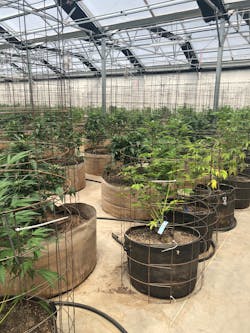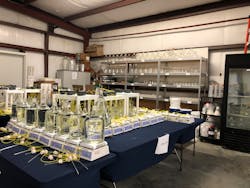The cannabis industry is relatively new and upcoming in the United States. As the industry grows and legalization expands, the impacts of wastewater generated from cannabis processing are also increasing. This requires research to inform regulators and policy makers enabling them to make the best decisions as they formalize wastewater regulation currently under development. Given that cannabis is still federally illegal under the Controlled Substances Act, many individual states have adopted their own policy regarding possession, use, growing, sale, distribution, and manufacturing of products involving cannabis.
Challenges to Best Practice Development
The difficulty in developing Best Management Practices and Good Manufacturing Practices for this growing industry is the lack of existing regulatory framework. This framework is normally developed by federally funded programs such as the Food and Drug Administration or the Environmental Protection Agency. Without this federal oversight framework, states have had to develop their own policies based on the limited information and sparse research published to date. Regarding the wastewater industry specifically, there is very little published data detailing the impacts that cannabis process wastewater has on overall treatability practices, whether it be in large municipalities or onsite treatment systems. This lack of reliable data has made it challenging for treatment plant operators and wastewater treatment system designers to anticipate and design for the potential impacts this cannabis processing wastewater will have on their operations.
Medical vs. Recreational Cannabis
Whether for medical or recreational use, cannabis plants are grown similarly. The difference is in cultivation and processing. The other difference is the concentration of CBD versus THC. Medical marijuana focuses on CBD extraction and processing because CBD is the active ingredient in cannabis that has been shown to provide calming and healing effects when used for certain medical conditions. It does not have the psychoactive impact of THC or the “high” that people look for in recreational use. Due to the use of grow houses, these medical marijuana facilities undergo a stricter, more controlled process with less pesticides, measured nutrient usage, and less environmental impact variability. Thus, these medical-grade facilities are generally more highly regulated and have better established Good Manufacturing Practices in place.
Cannabis Wastewater Handling Best Practices
For ease of explanation and design practices, the research presented here categorizes cannabis facilities in three ways: growers, processors, and end-product manufacturers. An additional factor that should be considered is any other use of the facility, specifically facilities that produce marijuana products for recreational use and may also serve as entertainment venues. All these facilities have treatment needs, but they are different. While it may not be practical to continuously characterize waste at each facility, there are some key practices associated with each of these categories that a regulator, operator, or designer can keep in mind when determining best practices for wastewater management:
• Growers may be using conventional insecticides and fertilizers and this usage will vary based on indoor versus outdoor grow facilities. Understanding what products are used and in what quantities, the product application, and the facility water usage practices will help determine waste characterization. Other growers are employing organic practices and have less wastewater impact. In either case, spent plant material will be part of the waste challenge.
• Processors also have spent organic material. In addition, they have waste oils, terpenes, and solvents that will potentially require a greater level of treatment prior to disposal. To develop wastewater handling best practices for processors, it is key to understand what extraction methods these processors are using, how often they are running these procedures, and how much waste is being generated on what type of timeline.
• End-product manufacturers’ wastewater streams may include oils, surfactants, industrial-type cleaners, waxes, and edibles. These food processing byproducts all present a unique set of potential challenges.
Key Questions for Wastewater Treatment Professionals
For wastewater treatment professionals, there are key questions that must be answered when charged with designing a cannabis wastewater treatment system. These can also be utilized as a guideline when developing a wastewater management plan.
1. What type of facility are you designing for?
a. Grower
b. Processor
c. End-Product Manufacturer
d. Combo of these
e. Medical or Recreational
f. Indoor or Outdoor
2. What processes will they be using specific to chemical use and residue?
3. What will the wastewater consist of?
a. Process
b. Runoff
c. Domestic
4. What are the wastewater parameters?
a. Average daily flow
b. Influent expectations
c. Effluent requirements
d. Site constraints or characteristics
e. Water usage
f. Recycling practices
5. What local regulations and design criteria exist?
Conclusion
Fully understanding cannabis wastewater characteristics and treatability/toxicity to domestic wastewater treatment processes is critical to developing sensible policy for the onsite wastewater treatment industry and for engineers, designers, and manufacturers of wastewater treatment products. Although we can develop treatment system design and waste disposal criteria based on the abovementioned guidelines, there is still insufficient data available on cannabis wastewater characterization to accurately develop efficient systems and procedures. Accumulation of that data is key to successful development of policy and procedure best practices for cannabis wastewater collection and treatment.
Another challenge is that state and federal law is not aligned when it comes to marijuana legalization. This hampers broad development of best practices that can be implemented across the U.S. Most other commodities or crops have a federal regulatory and best practices framework that allows for state implementation, with some adjustment to accommodate local conditions. However, given the conflict between federal and state legalization for this specific industry, that framework does not exist. This leaves the cannabis industry open for the potential regulatory nightmare of every situation implementing a procedure of its own. It is important for the wastewater industry to come together and share research and knowledge related to cannabis processing as this becomes a growing norm in the wastewater business. This will help frame regulatory policy that will serve the best interests of the manufacturers, regulators, consumers, and overall environmental health.
About the Author
Brenda Martinez has been the commercial project manager for Delta Treatment Systems (formerly Delta Environmental) for five years. She assists developers and engineers in designing wastewater treatment systems that will optimize treatment performance for their projects. Prior to working for Delta, Martinez spent 15 years in the environmental testing industry, doing bench-scale treatability studies for municipal wastewater plants as well as standard analytical testing for soils and waters under both Standard Methods and ASTM methodologies. She holds a bachelor’s degree in environmental science from Texas A&M University, a master’s degree in environmental management from the University of Maryland University College, and is currently a PhD student at Louisiana State University in the Environmental Science program. She can be contacted at [email protected].
About the Author
Brenda Martinez
Commercial Project Manager, Delta Treatment Systems
Brenda Martinez has been the commercial project manager for Delta Treatment Systems (formerly Delta Environmental) for five years. She assists developers and engineers in designing wastewater treatment systems that will optimize treatment performance for their projects. Prior to working for Delta, Martinez spent 15 years in the environmental testing industry, doing bench-scale treatability studies for municipal wastewater plants as well as standard analytical testing for soils and waters under both Standard Methods and ASTM methodologies. She holds a bachelor’s degree in environmental science from Texas A&M University, a master’s degree in environmental management from the University of Maryland University College, and is currently a PhD student at Louisiana State University in the Environmental Science program. She can be contacted at [email protected].



